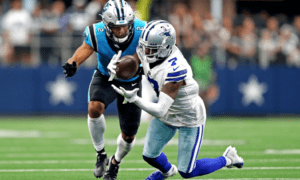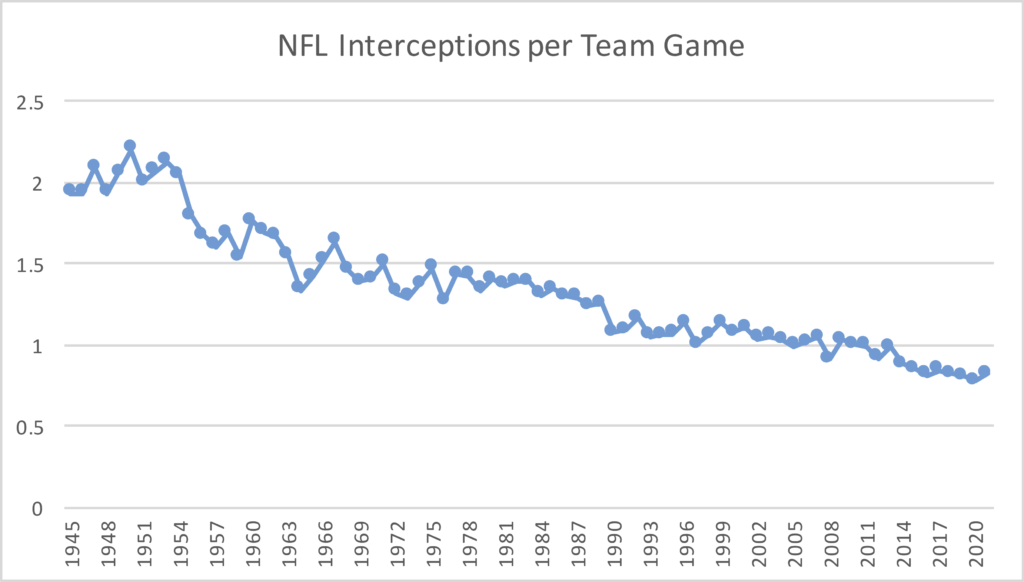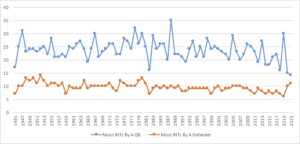 Cowboys cornerback Trevon Diggs has recorded 11 interceptions through 15 team games this season. That’s already the most in the NFL by any player since 40 years ago, when another Dallas corner — Everson Walls — also had eleven picks. Last year, I wrote about Xavien Howard and J.C. Jackson, the two AFC East cornerbacks who were doing something pretty remarkable. Both players had absurdly high interception numbers given the context of the modern game, which involves adjusting for era.
Cowboys cornerback Trevon Diggs has recorded 11 interceptions through 15 team games this season. That’s already the most in the NFL by any player since 40 years ago, when another Dallas corner — Everson Walls — also had eleven picks. Last year, I wrote about Xavien Howard and J.C. Jackson, the two AFC East cornerbacks who were doing something pretty remarkable. Both players had absurdly high interception numbers given the context of the modern game, which involves adjusting for era.
While teams throw more often now than they did throughout the history of the game, the frequency of interceptions per pass attempt has dipped at an even more severe rate than the quantity of pass attempts has risen. That’s why, despite more passing, there are fewer interceptions per game in the modern era than there has been at any other time since World War II. The graph below shows interceptions per team game in the NFL from 1945 through week 16 of the 2021 season:

Last year, I wrote about the seasons of Howard and Jackson in the context of Night Train Lane, the the putative gold standard for interception seasons.
When Lane intercepted 14 passes, the NFL average interception rate was 7.4% and his Rams faced 360 pass attempts. To try and make life fair across eras and teams (some defenses face lots of pass attempts, some face far fewer), let’s use a set of “baseline” numbers of a 3.5% league interception rate and a defense facing 500 passes. For Lane, this means we multiply 14 by (3.5% divided by 7.4%) and multiply that result by (500 divided by 360); that means Lane would have 9.2 interceptions in a more neutral environment. That is still a great number, but it’s not the best ever.
For a long time, the best mark belonged to Bill Dudley in 1946. Playing for the Steelers, Dudley had 10 interceptions when his team faced only 162 pass attempts! Of course, the average INT rate in 1946 was 9.1%, so that makes things just a bit less impressive. For Dudley, if we multiply 10 by (3.5% / 9.1%) x (500 / 162), we get an adjusted result of 11.9 interceptions. In other words, what Dudley did was slightly more impressive than Lane, even with 4 fewer interceptions, in large part because Dudley’s team faced less than half as many pass attempts!
…
But in 2020, another pair of AFC East players did the unthinkable. In New England, … J.C. Jackson intercepted 9 passes…. That is a remarkable number, particularly since the Patriots faced only 494 pass attempts and the league average interception rate in 2020 was a minuscule 2.2%. Jackson had an adjusted interception total of 14.54…
Jackson’s season should have been celebrated as one of the great defensive performances in modern history. Unfortunately, it was not only largely ignored, it wasn’t even the best defensive performance by a cornerback in his own division. Miami’s Xavien Howard had 10 interceptions last year! The Dolphins faced more passes (545) than New England, but not enough to offset the extra pick; Howard had 14.65 adjusted interceptions — (10 x (3.5% / 2.2%) x (500 / 545) = 14.65) — making it the best season in NFL history by this methodology.
Now, what about Diggs? Interceptions are slightly up this year, from 2.19% to 2.36% across the league. And while Diggs may have “only” played 15 games so far, his Cowboys have faced almost exactly as many passes (539) as Howard last year and already more than the 2020 Patriots. If we put Diggs’s numbers through the formula — 11 x (3.5% / 2.36%) x (500 / 539) — we get 15.14 adjusted interceptions, which would in fact be the greatest season of all time. [1]And Sam Darnold will be the key interview in the 30-for-30 series, as he threw 4 interceptions to Diggs, Howard, and Jackson over these three remarkable years.
There are two weeks left, of course, in the NFL’s inaugural 17-game season. If Diggs finishes with 11 interceptions, he will fall behind both Howard and Jackson as the Cowboys defense will face another 70 or so passes. [2]In fact, as it stands now, if he does not get an interception on any of the next 23 passes Dallas sees, he will fall behind both Howard and Jackson. If he gets to 12 is where it will get … Continue reading But as it stands now, one could very easily argue that — after adjusting for era — Diggs is having the greatest INT season in defensive history.
Or, we could have just summed up this whole article in one sentence: One out of every 36 interceptions this season was made by Trevon Diggs. [3]I will grant you that it seems — odd — that the top 3 INT seasons in history would have all occurred in the last two years. Perhaps that is a flaw in the model, or perhaps that is just … Continue reading
Edit: Here is a fun final chart to look at, comparing the amount of interceptions thrown by the NFL leader in each season in orange against the most interceptions recorded by a defensive player that season.

What stands out to you?
References
| ↑1 | And Sam Darnold will be the key interview in the 30-for-30 series, as he threw 4 interceptions to Diggs, Howard, and Jackson over these three remarkable years. |
|---|---|
| ↑2 | In fact, as it stands now, if he does not get an interception on any of the next 23 passes Dallas sees, he will fall behind both Howard and Jackson. If he gets to 12 is where it will get interesting — he will wind up very, very close to Howard, depending on the final league-wide INT rate and the number of passes Dallas sees. If the final INT rate is 2.40%, and Dallas sees another 58 passes over the last two games and Diggs has one interception, he would beat out Howard. But if the Dallas defense faces 59 passes, Howard would overtake him. Drama! |
| ↑3 | I will grant you that it seems — odd — that the top 3 INT seasons in history would have all occurred in the last two years. Perhaps that is a flaw in the model, or perhaps that is just random chance. I’d have to think about that some more, and urge you to do the same. |
